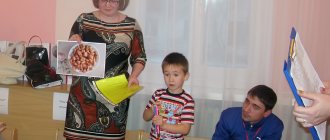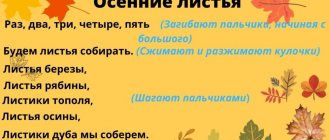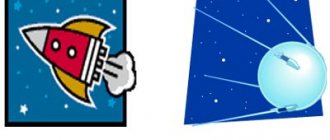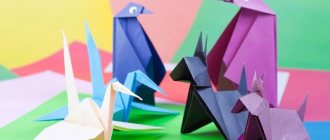MAGAZINE Preschooler.RF
“Children’s scientific and practical conference is an effective form of educational activity for the formation of prerequisites for the educational activities of older preschoolers”The report was prepared by:
- Maryasova Tatyana Georgievna, teacher of MBDOU "TsRR - d/s "Raduga"
- Bautina Elena Aleksandrovna, teacher of the MBDOU "CRR - d/s "Rainbow"
We would like to present to your attention the experience of our group in organizing a children's scientific and practical conference for older preschoolers.
A situation arises when first-graders have a large stock of knowledge and skills, but are not ready for educational activities. For the development of educational activity, its prerequisites must be formed in preschool age. It is for this reason that many kindergartens are focused on finding new forms and methods of work to create the prerequisites for educational activities. In our opinion, one of such promising forms is a scientific-practical conference.
In our kindergarten, the final event was a scientific and practical conference.
Topics of our conferences: “Our smaller friends” , “Indoor plants are our friends” , “Mysterious space” , etc.
Goal: creating conditions for the formation of prerequisites for educational activities through children's scientific and practical conferences.
Objectives of the Conference:
— creating conditions for self-realization for children of senior preschool age.
— creating conditions for scientific communication and developing public speaking skills.
— develop grammatically correct dialogical and monologue speech of children during the presentation of their project.
— to develop in children the ability to listen to each other and empathize.
— involve parents in the educational process of kindergarten on the basis of joint cognitive and research activities with children and teachers.
As part of the preparation, specialists and educators of the preschool educational institution drew up a scenario for the conference. Information about the date and location of the scientific and practical conference was posted in the corner for parents. The preparation of the reports was carried out by the students themselves and their parents, who received the status of scientific supervisors. They collected research material together with educators, who, as conference organizers, controlled the process of collecting abstracts for the conference.
The first conferences were a great challenge for us; we did not believe in our strengths, in the capabilities of preschoolers, we believed that this was not a form of work that was close and understandable to preschool children, and we were worried. Only active children capable of public speaking were selected to participate. Each time the participants in such conferences became more and more diverse, the children consciously carried out experiments, research and abstract reports.
Each presentation was fascinating, educational, interesting, containing facts from the life of animals, plants, and mysteries of space that were still unknown to children, to which relevant research was devoted. Parents and children used various forms of presenting messages: poetic form, question-answer, description, discussion with the audience, presentations.
Despite the fact that the time allotted for each participant to speak was 3-5 minutes, the excitement of the participants was obvious. Therefore, in order to relieve tension in the breaks between “scientific messages,” the parents of the participants conducted didactic games and relay races with their children.
During the final stage, the results of the conference were summed up. The results were summed up by the jury, which included the head of the MBDOU, the deputy head of the MBDOU and the chairman of the parent committee of the group.
Based on the results of the conference, all participants were awarded diplomas of various degrees.
Thus, the active use of this form of educational activity with preschoolers made it possible to form the prerequisites for educational activity in children. Pupils are active and inquisitive, show initiative and independence, are able to analyze, compare and generalize, and establish cause and effect relationships. Children accept the task assigned to them, think through and find not only ways of action to solve it, but also options for their implementation. Pupils subordinate their actions to the rule and know how to interact with each other.
We consider this form of teamwork to be effective and recommend using it in working with children of older preschool age and their parents.
| Next > |
Scientific and practical conference for preschoolers
Research activities at preschool educational institutions
Scientific and practical conference for preschoolers “Little Explorers”
Good evening! The school year has ended, and it’s time to sum up the results. I would like to present to your attention the experience of our kindergarten in organizing the research activities of older preschoolers. The modern world is dynamic and multifaceted. Everything that happens in it changes with kaleidoscopic speed, and now the life of a modern kindergarten is unthinkable without serious reliance on scientific achievements in the field of pedagogy, without the introduction of new technologies. One of these innovative technologies is children's research activities. Project activities help modern educators make their first children's discoveries. The content of project activities helps teachers select development tasks, and on the other hand, take into account the current interests of children. The result of the construction of the pedagogical process in our kindergarten was, on the one hand, greater interest in the cognitive development of pupils, and on the other hand, it aroused the desire of children to acquire knowledge on their own. The method of project activity, which is currently innovative for preschool institutions
Participants to a scientific and practical conference with their “scientific supervisors” Research activities in our kindergarten have long been included in the system of working with children, and some experience has already been accumulated. To carry out work using the project method, we use a variety of forms and methods, which allows us to involve all participants in educational relations in kindergarten. It has become a good tradition to hold various competitions for little researchers: “Scientists in diapers”, “I want to know everything!” the festival of child and parent projects “My Family is My Team”, the work of the “Knowledge” club has gained good fame, and at the end of February the 1st conference of the kindergarten “Little Explorers” was held in the kindergarten. The children's conference was attended by older children attending our educational institution. What did the little researchers learn? together with your parents and teachers in the process of your first discoveries? The topics of their research projects were very diverse. The boys talked about what new things they learned about cars and that. what you need to do to be healthy, and girls, of course. about dolls and sweets and fruits
Dasha presents her project. The presentation of children's projects took place in an atmosphere of positive communication, where each child felt his importance and the importance of his first discoveries. All your discoveries. so important for a small child, they performed under the guidance of their teachers and parents
How important it is to be healthy. Egor claims. on-site experience. Those who play sports will inflate the balloon in 5 exhalations, and those who don’t……. All little researchers were awarded medals of varying degrees, diplomas and gifts!
We recommend watching:
Project in the senior group of a kindergarten Project in the senior group on the topic “Trees and shrubs in spring” Practice-oriented project for landscaping the territory of a kindergarten Educational project. Second junior group
Similar articles:
Educational and creative project on the theme “Golden Autumn”. Junior group
Project for children of the senior group “Our cheerful garden”
Development of communication skills in design and research activities in preschoolers
Report on the topic “The importance of books in the life of a preschool child”
Preschool age is the age of fairy tales. A fairy tale awakens a child's
, gives an image of good and evil.
Through fairy tales, children begin to sympathize and empathize with fictional characters, who become familiar and close. Therefore, young children definitely need to read fairy tales - as much as possible. When buying a book for your baby, choose books
with thick pages so that it is easy for him to turn them over, the illustrations should be large and colorful, the image should be similar to the real object.
This will help the child form a correct idea of the subject. You should start reading with simple rhymes, nursery rhymes and short fairy tales. The value of works of oral folk art lies in the fact that the child himself can depict the actions of the characters or show what is being said with the help of a toy. For example, nursery rhymes: “The white-sided magpie”
,
“Water-water”
,
“The horned goat is coming”
, etc.
Great importance
For understanding, fairy tales have repetitions, which sometimes tire adults, but are very important for children. Recognizing familiar phrases, texts, and events gives children a sense of awareness of their surroundings, helping not only memorization, but also living. Repetitions of certain texts and events are contained in almost all fairy tales.
The very first fairy tales "Kolobok"
,
“Teremok”
,
“Turnip”
are built on the repetition of the same fragments.
As you grow older, you should select more complex and longer fairy tales from Russian and foreign children's writers. In life
preschoolers include author's fairy tales - C. Perrault, G. H. Andersen, the Brothers Grimm, B. Zakhoder, etc. when choosing
books
by these authors, it is important to pay attention not only to the pictures, but also to the quality of the text
(i.e. translation)
.
Many famous children's books
are not written in children's language at all.
You need to read fairy tales slowly and expressively. Each fairy tale must be read not once, but several times until the child
understands it completely.
From repeated repetition the child
, but on the contrary, it becomes more loved and loved.
From time to time it is necessary to return to what has already been read - this gives the child special pleasure
.
And when the child already learns to read on his own, of course you should pay attention to the font
: it should be large so as not to spoil his eyesight.
The most important rule
: under no circumstances should you hold a child against his will.
Reading books
can last from 5-10 to 20-30 minutes.
After all, all children are different, some can listen to fairy tales for an hour, while others can listen to them for no more than 5 minutes. Reading books
should bring joy to both – an adult and
a child
.
Reading books
allows an adult to plunge into the world of childhood; the birth of a child provides this amazing opportunity.
Let it be every time a journey to a fairyland, where dreams come true, there are no adult problems, and good always wins. read books regularly
. Reading should become a regular tradition, for example, before bed.
Good afternoon, dear guests of our site! Yesterday was a significant day in our kindergarten. We welcomed young researchers and their mentors within our walls as part of the III scientific and practical conference “Play! Explore! Think!” Holding this event has become a good tradition of our institution.
Why does it rain? Why does water flow? Why does the borscht blush? Why does the star burn? Why does a cat lick its paw? Why is there no day at night? Why does my dad call me Why?
The symbol of our scientific and practical conference was the Owl, as it is a symbol of wisdom.
Owl , owl, little owl, Wise little head, What are you thinking about, wondering about, Tell us what you know. Where and who, when did you visit, who walked in your forest? You are an elder in the forest, with glasses on your nose. And a big head, And the same eyes, Vigilantly guard the night, And in the forest, blinking in the distance. There is no wiser head, Our little owl.
It's time to share our discoveries made this school year. We will present you with great interest the creative ideas of the participants of the scientific and practical conference. So here we go!
Who among you hasn’t dreamed of eating a lot of sweets and chocolate instead of soup, porridge and cutlets! Conference participant Kira told everything about chocolate.
Snow is not only winter fun, it is a subject of study that contains so many interesting, curious and attractive things. And most importantly, you don’t have to go far, here it is – the subject of research, under your feet! Amazing is nearby! Gleb from the Romashka group revealed to us the secrets of snow!
Are you interested in knowing what a “soap bubble” is and how it appears? Is it possible to prepare a composition for soap bubbles at home and what is needed for this? Which solutions can produce the largest and strongest soap bubbles? Polina found answers to all questions about soap bubbles!
Caucasian legend about lemon
One day, the beloved servant of one of the Caucasian kings fell out of favor for some offense. The enraged master ordered his servant to be immediately imprisoned and ordered the guards to feed the prisoner only one type of food. When asked which one, the Bishop, having mercy, answered: “Let him choose himself.” The prisoner had no choice but to fulfill the royal will. And he complied with it, asking to give him only... lemons. And he explained to the puzzled guards:
“The aroma of lemon will cheer my thoughts, the peel of the fruit and grain will be good for my heart, in the pulp of the lemon I will find food for myself, and with the juice I will quench my thirst.”
Now it is difficult to say whether this really was so. But one thing is certain: this ancient legend accurately reflects the meaning that these fruits had for our ancestors.
Lemon is a mysterious fruit. Firstly, no one has ever seen a wild lemon - its image is hidden from us in riddles and secrets. Secondly, the lemon has no homeland - scientists still cannot figure out who on Earth this honor belongs to. Lemon fruits have long been considered beneficial for humans.
And Denis shared with the conference participants about lemon and experiments with this amazing fruit.
I have a lot of toys at home: cars, soldiers, transformers and others. But the first place among them for me is occupied by designers. Together with our friends, we design various equipment: airplanes, tanks, cars. After assembly we start the game. Of course, it happens that during our games, parts cannot withstand heavy loads and become detached, but we do not lose heart and build our models anew. Our parents cannot tear us away from games for a long time, because the games are always new: every time more and more new design ideas come to mind. Once my mother asked me a question: if I am so passionate about construction kits, would I like to know how and when they appeared. I thought about it and agreed. This is how my “research” began. Kostya from the Bell group told us about this.
Popular wisdom says: “Bread is the head of everything.” Not a single modest breakfast, everyday lunch, or holiday table is complete without bread. All the guys love bread. One day we noticed that there were holes in flour products... I became interested in what these holes were, what they were called and where they came from in bread. And I decided to find out about it.
Therefore, the topic of my research is called “Where do the holes come from in bread?” - Veronica said.
Who among us doesn’t know what an onion is? Most likely, there are no such unknowns. And you don’t have to be an experienced onion grower to grow this plant. White, purple, yellow – there are so many colors of this oldest vegetable crop on earth. Veronica from the Forget-Me-Not group knows everything about onions.
Not just children, but future great physicists come to our kindergarten! Kira from the Snowdrop group knows a lot about the density of substances.
“Face to face - you can’t see the face. Big things are seen from a distance,” wrote the brilliant singer of Russian nature Sergei Yesenin. We are lucky - we live in the most picturesque places. Foreigners coming to Siberia admire its beauty. Let's listen to our planet, the voices of animals and birds, flowers and trees... It's only in fairy tales that they speak human language. You can hear and understand nature with your heart. Seeing and understanding beauty is a very important quality for a person. Only those who can appreciate the unique beauty of the world around them are able to cherish this miracle of the universe - our living planet.
Lena from the Kolokolchik group told the conference participants about the Red Book of the Tyumen Region and why the brown hare is included in this book.
Research activities in our kindergarten have long been part of the system of working with children, and some experience has already been accumulated. To carry out work using the project method, we use a variety of forms and methods, which allows us to involve all participants in educational relations in kindergarten. We express our gratitude to all participants of the III scientific and practical conference!
The information was prepared by senior teacher Kolmakova L.F.





